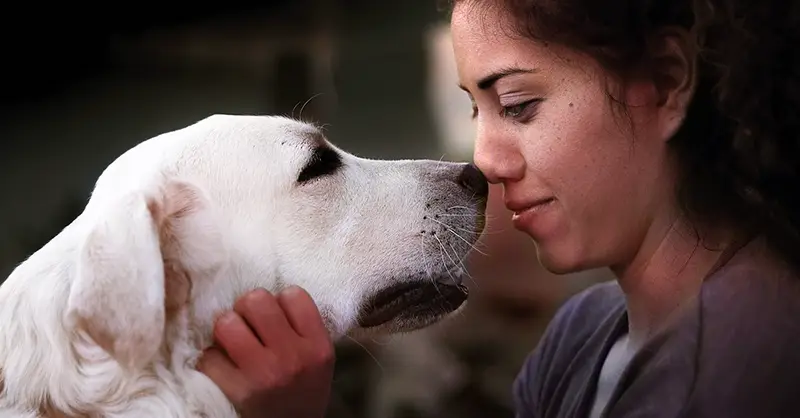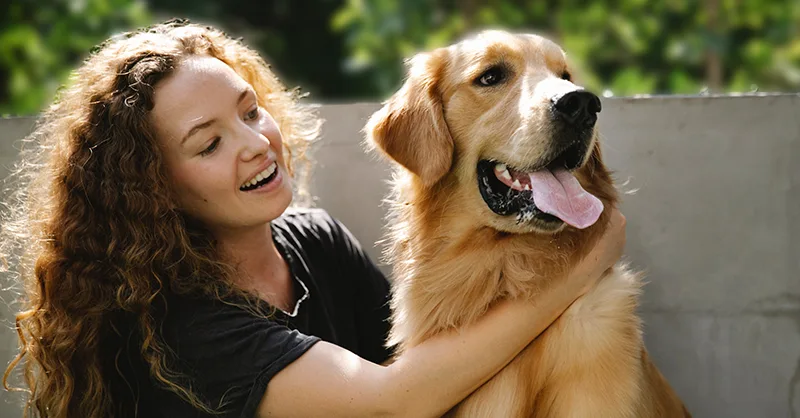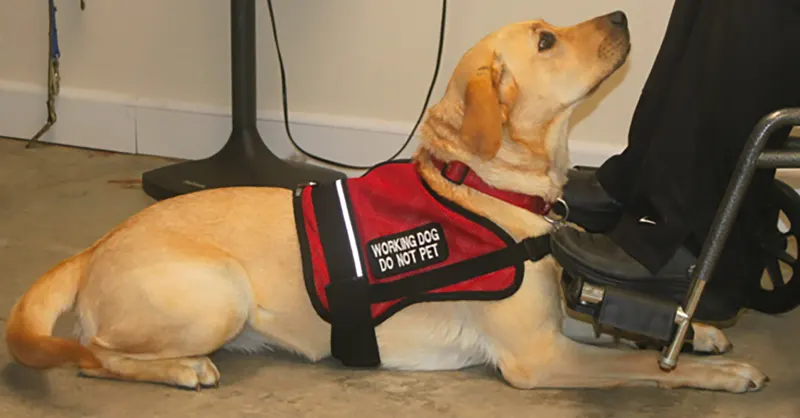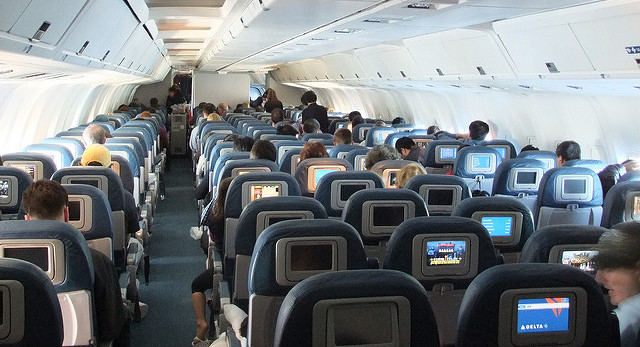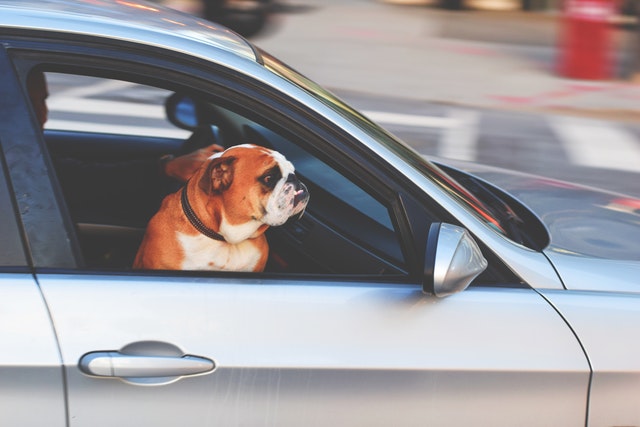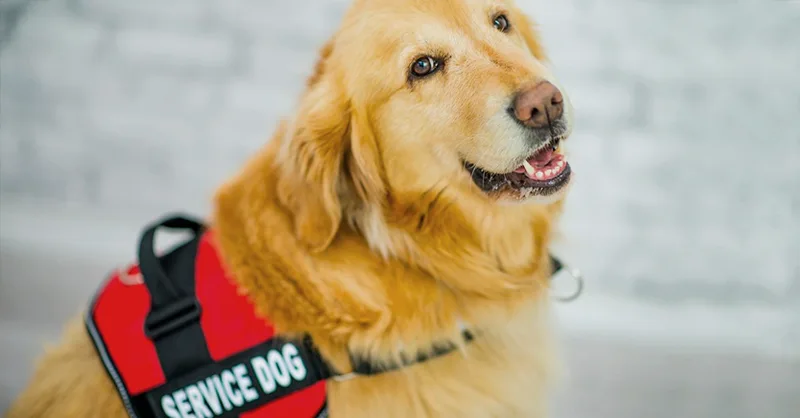Archive for the ‘Service Dog Tips’ Category
Delta carries approximately 250,000 Service and Emotional Support Animals each year. However, as of March 01, 2018, they are tightening their policy for these working animals in an effort to reduce “misbehavior” by dogs (and other creatures). Although the carrier is required by law to admit Service animals and ESA’s into the cabin of the craft, they can and are putting extra rules into place.
What is the new policy? How does this affect those with disabilities that need a Service Dog? Read on for the important facts you will need to know before you book your next flight with Delta.
What is a Service Animal?
There is a difference between a Service Animal and an Emotional Support Animal. Service animals are typically dogs that have been trained to perform a specific task for an individual with a disability. This can be any number of things from picking up dropped items to opening doors, to alerting the person to an oncoming medical situation.
The Emotional Support Animal, on the other hand, is there only to provide the individual with comfort and support. These can be of any species of animal and do not need to be trained for a specific service, other than comfort.
Why is Delta Changing Their Service Dog Policy?Delta has seen a surge of 150 percent in service animals (that by Federal law must be allowed to fly uncaged and at no additional cost to the passenger) since 2015. However, there have been incidences of customers “attempting to fly with comfort turkeys, gliding possums known as sugar gliders, snakes, spiders and more.”
This has increased the complaints from Delta passengers concerning allergies, and other disturbances, as well as abuse to the Service Dog policy, with some of these clients just trying to fly their pets for free.
With an average of more than 200 service animals and 500 support animals flying on a daily basis, and the fact that in-flight incidences with these types of animals have risen 84 percent since 2016, Delta felt the need to change-up their policies.
Delta said; More untrained animals are being brought onto planes, where they urinate, defecate, bark, growl, lunge and exhibit other behavior uncommon among companions that are properly taught.”
What is the New Delta Policy Regarding Service Dogs and Emotional Support Animals?As of the first of March 2018, Delta will require all passengers with service dogs or emotional support animals to submit proof of health or vaccinations. This will have to be done through Delta’s website 48 hours before flight time.
Those customers requiring an ESA or Psychiatric Service Animal must (in addition to the health record) sign a document stating the animal’s “ability to behave in the cabin or risk being barred from boarding or removed from the plane.”
However, Delta does not require any proof that the animal has graduated from obedience school. But be aware that you will need to provide a letter prepared and signed by your licensed mental health professional explaining why you need an ESA to accompany you on the flight.
Where can I get the new Delta service dog forms?
Before you fly with Delta, be sure to visit their website to download the proper forms you will need before your flight. The new Delta service dog travel forms can be accessed here.
Behaviors Delta Will Not TolerateWith these stricter policies, Delta urges those folks traveling with animals in the cabin of the aircraft to have their “working” animals under control at all times. Behaviors that will not be tolerated include;
Growling Jumping on passengers Relieving themselves in the gate area or cabin Barking excessively, not in response to a handler’s need or distress Eating off seat back tray tablesDelta reserves the right to refuse transportation for any animal exhibiting unruly behavior.
Conclusion
If you are planning a trip on Delta airlines and need a Service or an Emotional Support Animal, be sure to have your animal’s health or proof of vaccination certificate. If you are traveling with an ESA or psychiatric service animal, you will also need a note from your mental health professional stating your need for the animal. Be sure to visit Delta’s website for further downloads and let them know you will be traveling with a “working” animal 48 hours prior to your flight. To register your service animal and receive your service dog certification, complete the registration in the link below.
Uber is working to make catching a ride easier, safer, and always a five-star experience. They connect the rider with affordable transportation anytime, anywhere, all at a tap of a button. You can also see your driver’s contact information and the vehicle’s details in the app, so you will always know you’re getting into the right car.
This company is working towards making the most affordable and pleasant experience they can when it comes to using this type of transportation, and that includes working with those folks that need a Service Animal.
In this post, we will cover Uber’s Service Animal policies in both the United States and Canada, so that you can ride in style and with peace-of-mind.
Does Uber Allow Service Animals?US and Canada Uber drivers must allow service animals in their vehicles. If you experience discrimination, please contact Uber customer service.
In both the United States and Canada, Uber does allow Service Animals into their vehicles. However, be aware of their definition of “service.”
According to Uber’s website, a Service Animal is one that assists the person with a disability that is both visible and nonvisible.
What Are the Uber Rules in the United States Regarding Service Animals?Uber in the United States does allow Service Animals in their vehicles as both state and Federal laws prevent the discrimination against these working animals.
In the US, Uber defines a Service Animal as one that is trained to perform tasks for an individual with a disability.
There are only two questions a driver may ask the disabled individual to confirm his/her need for the Service Animal;
1. Is the animal required because of a disability? 2. What work or task has the animal been trained to perform?Note: The driver-partner may not request that the rider present documentation proving that the rider’s animal is a Service Animal. In the United States, there is also no requirement that a Service Animal must wear a tag, be registered, or display any proof that it is a Service Animal.
If you require a Service Animal and are refused entry to an Uber due to having one, the driver-partner will be permanently banned from using the Driver app.
There are also no cleaning fees charged for the shedding of a Service Animal or the first and second reported incidences of its bodily fluids. However, you may be charged a cleaning fee for the third reported incident of bodily fluids emitted by your Service Animal.
What Are the Uber Rules in Canada Regarding Service Animals?If your Uber driver does not accept your Service Animal, you can contact Uber’s customer service.
There are two ways that Uber will qualify an animal as a Service Animal in Canada;
1. The animal is easily identified as a service animal. For example, it is wearing a service vest or harness and is helping the individual. 2. The person may also present documentation confirming the animal is a Service Animal. This could be in the form of a letter from a health professional stating that the animal is needed due to a disability, a government-issued Service-Animal card, or, in Quebec, a certificate from a Service-Animal training school.Note: In Canada, a driver may ask to see this documentation.
Canadian laws prohibit Uber driver-partners using the Driver App from discriminating against riders with Service Animals.
If a driver refuses to give the rider service due to a Service Animal, it is considered to be a discriminatory act, and they will lose their ability to use the Driver app.; as explained in Uber’s Non-Discrimination Policy,
“Riders cannot be charged cleaning fees for shedding by their service animals. Riders will be refunded any cleaning fees charged for shedding by their service animals.
A rider will not be charged for the first or second reported mess involving a service animal’s bodily fluids. A rider can be charged for the third reported mess involving a service animal’s bodily fluids. The rider may contest that such a mess occurred by responding to the fee notification email to notify customer support.”
Riding With “Non-Service” AnimalsThe definition of “Service Animal” within the Uber policy is well-defined. Therefore an Emotional Support Animal would not fall under this definition. According to their website, when riding with “non-service” animals they suggest it’s good practice to contact the driver who accepts your ride request. Using your app, send a text message or call to let the driver know you’d like to bring a pet.
They also suggest you bring a crate or blanket to help reduce the risk of damage or mess. Some drivers may keep a blanket in the trunk.
Conclusion
Both the United States and Canada will accept the Service Animal in the Uber, but both regions also have their requirements; this is especially important to know if you are traveling from one country to the next. Know your rights when it comes to bringing your Service Animal in an Uber and plan accordingly.
If your landlord or an employee at a store asks if your service dog is certified, what exactly does that mean? What precisely do you need to prove you own an actual service dog?
In this guide, we’ll explore 5 things to consider about getting a certified service dog so you can confidently answer if someone asks about your service dog.
#1 – Do you qualify for a service dog? Service dogs can help people with many different types of disabilities.Service dogs can be incredible companions and helpers for individuals with various disabilities. Here’s a quick rundown of the qualifying criteria for a service dog:
Having a disability: To be eligible for a service dog, a person must have a physical, sensory, psychiatric, intellectual, or other mental disability that significantly impacts one or more major life activities. Requiring assistance related to the disability: The individual needs to benefit from tasks specific to their disability that a service dog could perform.How do you know if you have a qualifying disability? Under the Americans with Disabilities Act (commonly known as the “ADA”), your condition must be severe enough that it substantially limits a major life activity. If you have a mental health issue and are unsure if you qualify, a PSD letter from your therapist or doctor can be useful.
#2 – Training your service dog to aid in your disability You can train your own dog to be a service dog.Professional training organizations: Before you can correctly call your dog a service dog, it must be fully trained to perform a task directly related to your condition. Some organizations offer fully trained service dogs for adoption, but that’s not a realistic option for many people since the cost can run from $20,000 to $60,000.
Alone or with the help of a professional: You’re allowed under the ADA to train a service dog yourself (either on your own or with the help of a professional trainer). Utilizing the services of a good trainer is highly recommended if you lack experience in dog training or if it is difficult for you to do so alone because of your disability.
Service dog tasks for individuals with physical disabilities:
Mobility assistance: helping individuals stand up, sit down, navigate stairs and uneven terrain; pulling wheelchairs Fetching and carrying items: retrieving objects for handlers, carrying items in specially designed backpacks or pouches Opening and closing doors: operating door handles, pushing buttons, tugging on ropes to open and close doors Alerting to sounds: alerting their handlers with hearing impairments to essential sounds, such as doorbells, smoke alarms, or approaching vehicles Obstacle avoidance: helping handlers avoid obstacles in their path, such as furniture, poles, and curbs; steering handlers through crowds Intelligent disobedience: refusing a command if it puts their handler in danger Emergency assistance: seeking help by finding and alerting others or, if necessary, operating specialized devices, such as emergency call buttonsService dogs perform a wide range of tasks for the physically disabled. But what about those with psychiatric conditions? Psychiatric service dogs are also called upon to perform an incredible variety of jobs:
Anxiety and panic attack response: recognizing early signs of anxiety or panic attacks; responding by providing physical comfort, such as nuzzling, leaning against their handler, or placing their head on the person’s lap Interrupting harmful behaviors: gently interrupting self-harming behaviors or compulsive actions by nudging or pawing at their handler Medication reminders: recognizing the right time and alerting handlers to take medication on schedule Nightmare interruption: recognizing signs of distress and waking handlers, especially those with PTSD Assistance during dissociation: helping regain focus and awareness by providing tactile stimulation or guiding to a safe space Crisis intervention: seeking help when the handler is in severe emotional distressA bonus for any service dog is their emotional support and companionship. The bond between a handler and their service dog can positively impact the individual’s overall well-being, providing a constant source of comfort and stability.
#3 – Good citizenship and public access training Starting training at a young age will help weed out bad habits.Public access rights: The ADA gives service dog handlers the privilege of accessing public spaces where animals are typically not permitted. It is the handler’s responsibility to ensure that their service dog remains under their diligent supervision and exhibits exemplary behavior in public settings.
Public access readiness: Before venturing into public environments, it is essential for service dogs to successfully complete a public access test, proving their ability to stay attentive to their handler’s needs and refrain from causing any disturbances in various public surroundings.
Limits to public access: Having a well-behaved service dog that is under your control at all times is essential. If a service dog is acting unruly, aggressive, lunging, barking excessively, or otherwise acting in a dangerous, disruptive, or unsafe manner, it can be asked to leave the premises.
The handler should ensure their service dog can perform its duties in all types of situations, including public environments with many distractions and people.
#4 – Certifying your service dog A good dog citizen knows to stay calm in public and will listen to their handlers.Once you have fully trained a service dog for your disability, you can obtain a certificate to recognize your accomplishment. Note that certificates and registrations are not mandated by the ADA, and they are not shortcuts for following proper qualification procedures.
Obtaining certification for your service dog can be useful for several reasons:
Recognition of training: Certification serves as tangible proof that the service dog has undergone rigorous training to meet specific criteria and standards, ensuring their ability to assist their handler effectively and safely in various situations. Public awareness and acceptance: A certified service dog can be more likely to be welcomed and respected in public spaces. The certification demonstrates to others that the dog is trained to behave appropriately and unobtrusively, thus alleviating concerns or misunderstandings. While no one can insist on seeing a certificate as a condition of entry, service dog handlers know that people frequently do this regardless. Reduced skepticism and questioning: A service dog with documentation can encounter fewer challenges or inquiries from business owners or the public. Enhanced handler confidence: Knowing that their service dog is certified can boost a handler’s confidence in knowing they have done everything the right way to achieve service dog status.Items like ID cards, vests, and tags fall under the same boat as certifications. They are not necessary but are helpful for service dog owners who want physical tools to signal that their dog is special.
#5 – Verifying your service dogWhat should you do if you’re out in public and someone asks if you have a service dog?
Under the ADA, third parties can ask two questions to verbally confirm you have a genuine service dog. Note that if your disability is obviously apparent (for example, if you are in a wheelchair), third parties cannot badger you with these questions.
The two questions that can be asked are:
Is your dog a service dog required for a disability? What work or task has your dog been trained to perform?Service dog owners have a right to privacy. That means that third parties cannot pester you about the specifics of your health condition or ask that you have your dog perform its task on the spot. These rules are designed to protect the integrity of service dog ownership and preserve the dignity and confidentiality of service dog handlers.
Keep in mind as well that if you are flying with a service dog, the airlines will require certain documents. Take a look at this guide for helpful instructions on how to fly with a service dog.
